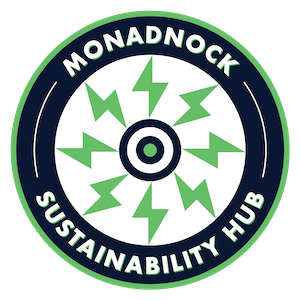Community Power
What if local communities joined together to purchase cheaper electricity and ensure a more sustainable energy future?
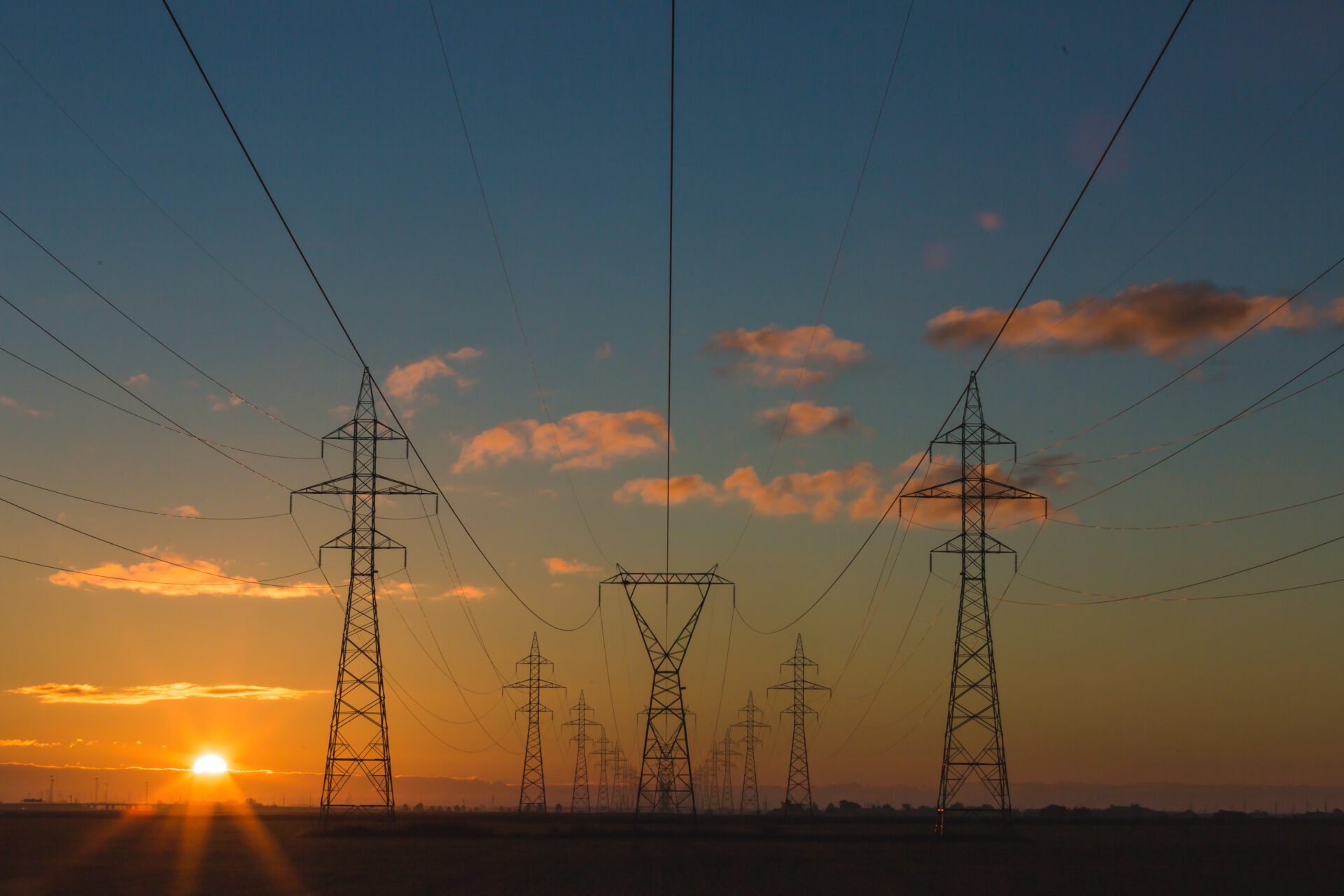
New Hampshire Community Power 101
What is Community Power?
Community Power (sometimes referred to as Community Choice Aggregation) is a new New Hampshire program—established in 2019 by legislation RSA 53-E—that allows local governments to buy electricity for all of their residents and small businesses at wholesale prices. In other words, it’s a bulk purchasing program for electricity. Municipalities work in collaboration with experienced service providers who know the electricity market so town staff do not need expertise in the energy sector. While communities with Community Power programs can purchase electricity on the wholesale market, they do not own or maintain the poles and wires. Repairs, power outages, and routine upgrades are taken care of by the utilities.
In Collaboration with South West Region Planning Commission
![]()
Thanks to our friends at SWRPC for collaborating with us to bring Community Power to Monadnock Towns.
MSH Supports Communities in their Pursuit of Community Power
Are you a Monadnock resident interested in bringing Community Power to your community?
MSH offers free Community Power presentations and support to residents, Select Boards and town leaders, and community groups/committees who are interested in learning more about Community Power. Contact us to learn more.
Some municipalities and cities may choose to operate a Community Power program on their own. However, the Community Power Law allows communities to join together and create a shared program, which allows them to take advantage of economies of scale and share overhead costs.
Note that when a Community Power program is started, individual participation is optional. Depending on the structure of the Community Power plan, businesses and residents can “opt-out” of a Community Power program, in which case the utility will likely reassume the role of procuring such customer’s energy supply. In other cases, a Community Power program may require residents and businesses to “opt in”, rather than setting the program as the “default”.
How Community Power Changes the Way We Get Electricity: A background of New Hampshire’s electricity sector
To understand how Community Power is changing the game of electricity—and how individual residents and businesses will be affected by Community Power—it’s first beneficial to know the background of electricity in New Hampshire.
The Supply Chain Behind Your Electricity
Though some residents and businesses may opt to generate their own power or buy from a different supplier, the vast majority of us receive our electricity from the default electricity provider: the utility. For most communities in the Monadnock region, this is Eversource. Utilities are responsible for sourcing electricity from electricity producers, such as a coal operated power plant or a commercial solar farm.They then distribute this electricity to their customers via “poles and wires”, which they are responsible for maintaining and operating. Note that the only service the utilities profit from is electricity distribution, which is represented on your electricity bill as the delivery charge. They do not make a profit on charges or costs related to electricity supply.
This structure of electricity supply and distribution—and the role of the utility in the electricity supply chain—may seem normal, but it has not always been done this way…
A Brief History of New Hampshire’s Electricity Sector
In the late 1800s, when utilities were “up-and-coming” players in the nascent electricity industry, the structure of a regulated and standardized electricity sector was born. Country-wide, utilities were deemed regulated monopolies and granted exclusive rights to generate and deliver electricity, operating in a designated territory. In other words, utilities had control over the entire electricity supply chain (including supply, transmission, and distribution of electricity). Utilities were overseen by a state regulatory agency (in New Hampshire it’s the Public Utilities Commission), who was responsible for regulating and approving the electricity prices utilities could charge.
Utilities remained the primary producer, supplier, and distributor of electricity for the next century. It wasn’t until 1996 that the utilities’ dominant role in the electricity sector began to change. That year, New Hampshire was the first state to restructure the “status quo” with the Electric Industry Restructuring Act. This legislation removed the vertical integration of New Hampshire’s electricity sector, ceasing utilities’ rights to generate electricity, leaving them only responsible for procuring and distributing electricity to their customers. This led to the formation of a more competitive electricity generation market. The goal of this restructuring was to bring more competition into the electricity sector in order to bring down electricity rates and improve consumer choice.
How Community Power is Changing the Game
Community Power takes the restructuring of the Electric Industry Restructuring Act one step further by enabling towns, cities, and counties to take control over their electricity supply. Under a Community Power program, the municipality (with the assistance of a service provider) is responsible for procuring electricity for their residents and small businesses, which involves choosing which producers/supplier(s) to buy electricity from and negotiating rates. This is not a simple task, which is why Community Power programs enlist the help of service providers with expertise in the energy sector. The utilities remain responsible for the distribution of electricity and the management of the “poles and wires”.
Some municipalities and cities may choose to operate a Community Power program on their own. However, the Community Power Law allows communities to join together and create a shared program, which allows them to take advantage of economies of scale and share overhead costs.
Note that when a Community Power program is started, individual participation is optional. Depending on the structure of the Community Power plan, businesses and residents can “opt-out” of a Community Power program, in which case the utility will likely reassume the role of procuring such customer’s energy supply. In other cases, a Community Power program may require residents and businesses to “opt in”, rather than setting the program as the “default”.
What are the Benefits of Community Power?
Local Control – Towns can choose what companies to buy electricity from, and the source of that electricity, so that it reflects their priorities.
Increases Renewables – If a community prioritizes renewable electricity sources, Community Power makes it possible to purchase more of their electricity from renewables like solar, wind, and hydro.
Cost Effective – Because they are contracting on behalf of all of a town’s residents, Community Power programs can often negotiate lower and more stable electricity prices than the utility rate.
Promotes Equity – Community Power allows residents of all income levels to enjoy the benefits of renewable energy. You don’t need to buy expensive solar panels or even own your home. You just need to pay your electricity bill.
New Products and Services – Community Power programs can establish a reserve fund to finance a variety of locally-determined projects, such as: local renewable energy development, batteries for residents and businesses for use during power outages, and energy efficiency renovations in low and moderate income homes.
Educational Materials for Communities & Committees
Check out our Community Power educational materials. We encourage you to share these printable materials with your community!
Community Power Basics – Printable Handout
When using our public educational materials, we ask you to please keep the Hub logo on the handout and credit the Hub, thanks!
Cheshire Community Power – Community Power Coalition of New Hampshire slideshow from May 24, 2023
The Path to a Community Power Program – Where to start?
Here are the key action steps to launch Community Power in a New Hampshire town:
1. The Select Board appoints a Community Power Committee (sometimes referred to as an Electric Aggregation Committee, or EAC).
2. The Committee researches Community Power plans and service providers.
3. The Committee develops a Community Power Plan, with input from the community. Service providers often provide assistance with drafting the plan.
4. The Committee holds public hearings to educate the town about the Community Power Plan and get residents’ feedback.
5. Residents vote to approve the Plan at Town Meeting and the Plan is submitted for approval by the Public Utilities Commission.*
6. The Public Utilities Commission approves the Community Power Plan.
7. The town signs a Community Power contract with a service provider and, together, they send an announcement to residents about the new Community Power plan and provides them an opportunity to opt-out of the program.
8. The program is launched.
*Note that this process looks different for cities—instead of the Plan being approved by voters during a Town Meeting, the City Council or Council of Aldermen must approve the plan. Also, any town in Cheshire County can adopt Cheshire County Community Power by a “Yes” vote of its Select Board – without a Town Meeting article on the question.
Community Power in the Monadnock Region
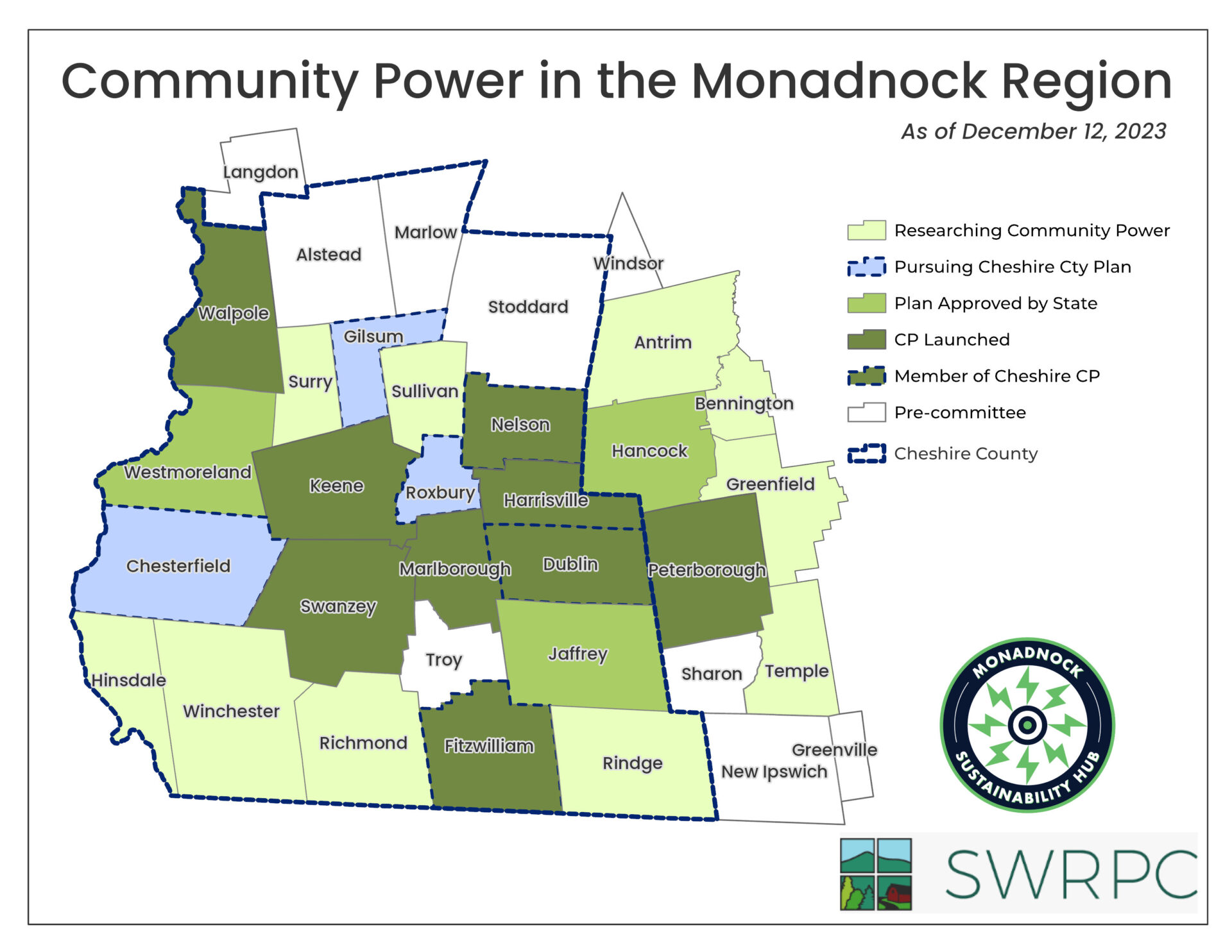
Community Power is making strides in the Monadnock region! Here’s an overview of which communities are making progress with a Community Power Program. (Updated August 2023)
Keene
Keene was the earliest adopter of Community Power in the state. The City’s interest in Community Power was driven in part by its adoption of 100% Renewable Energy Goals and is an integral part to its Clean Energy Plan. In mid 2020, the City established a Community Power Committee, which was tasked with writing a plan for a Community Power Program. In May of 2021, the Keene City Council approved and adopted this and in the Fall of 2022 the PUC approved the plan. Keene’s Community Power launched in June 2023.

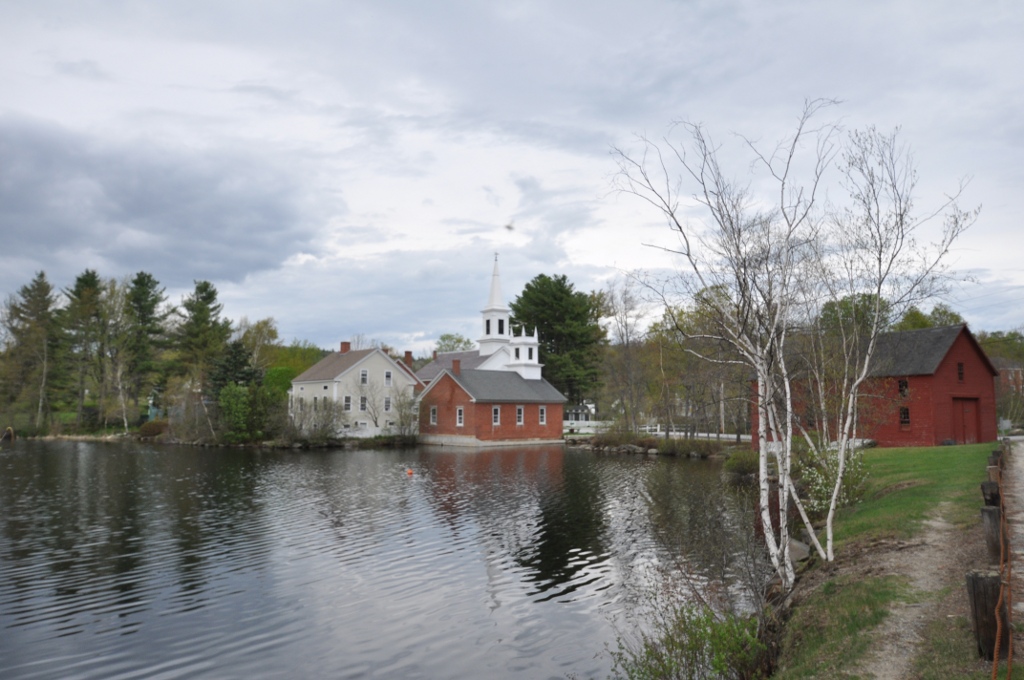
Harrisville
Community Power is not just for large towns and cities—Harrisville is a great example of how a small (but passionate) town can adopt Community Power. In April of 2020 Harrisville established an Electric Aggregation Committee and in May of 2021, Harrisville voters were the first to pass a Committee’s Community Power Plan at their Town Meeting. PUC approval followed in early 2023, and in May 2023 the town was among the first cohort of towns and cities in the state to launch Community Power!
Learn more about Harrisville’s Community Power journey & program
Swanzey
Swanzey established their Community Power Committee in March of 2021. The Board of Selectmen spent the next 10 months researching, holding public hearings, and drafting their Community Power Plan. The plan was passed by residents and adopted on January 5th, 2022, and received Public Utilities Commission approval in December 2022. Swanzey launched its Community Power Plan in June 2023!
Learn more about Swanzey’s Community Power journey and & program
Read Swanzey’s Community Power Plan.

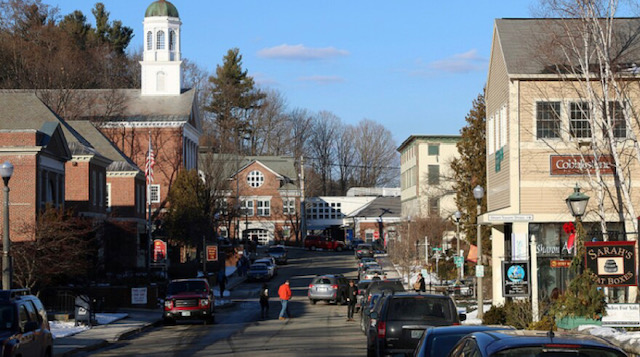
Peterborough
Peterborough established their community power task force during the summer of 2021 and spent the fall and winter drafting their Community Power Plan. The plan was passed in May of 2022, and PUC approval followed in December. Peterborough was among the towns and cities across the state that launched Community Power in May 2023 – firsts for New Hampshire!
Learn more about Peterborough’s Community Power journey & program
Walpole
Walpole established the Walpole Community Power Committee (WCPC) in 2021 and adopted their Community Power Plan in March 2022. In December 2022 the state approved the plan, and in May 2023 Walpole was in the cohort of the first towns and cities in the state to launch Community Power!
Learn more about Walpole’s Community Power journey & program
Read Walpole’s Community Power Plan
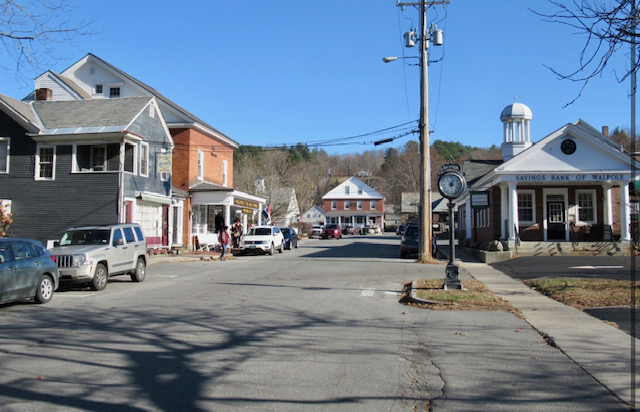
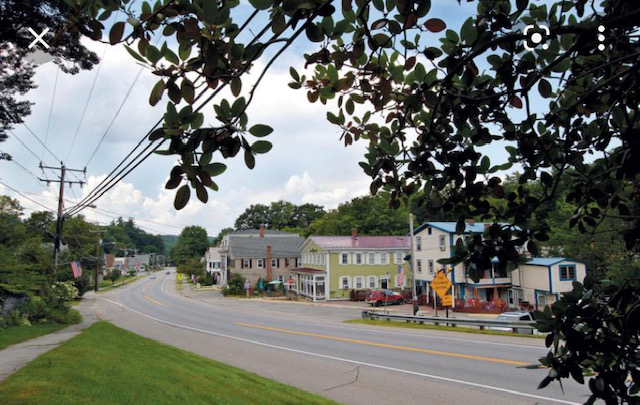
Marlborough
Marlborough established their Community Power Committee in May of 2021. The committee surveyed the community to assess their needs and interests in October of 2021. The draft Community Power Plan was sent to the Select Board in March 2022 and was subsequently passed. In March 2023 Marlborough announced its Community Power Plan will launch in June – and it did!
Learn more about Marlborough’s Community Power journey & program
Monadnock Communities Researching or Pursuing Community Power
On top of those Monadnock towns that have launched Community Power plans, there are more in the pipeline. At least nine towns in our region are currently researching Community Power (light blue on the map above). Westmoreland’s plan has been town-approved and awaits state-level approval in order to commit to a service provider and then launch their plan. Hancock and Jaffrey have state-approved plans and after selecting a service provider they will be able to move towards their launches.
Within Cheshire County, several town select boards have approved membership in the county’s plan, which is already state-approved and will launch in November, 2023. At this time, residents throughout Cheshire County are able to “opt in”, regardless of their town select board’s actions. Several other towns seem to be moving towards the county plan, and are likely to get on board in 2024.
We encourage residents eligible to participate in any community power plan to give serious consideration to opting up from your plan’s default renewables mix (currently either 23.4% or 33%) to a higher one (33%, 50% or 100%). This can be done by contacting your plan’s service provider by phone or a website contact form. Check your town’s community power page if unsure how to do this.

Learn More About Community Power
2020 – 2021 Monadnock Community Power Group Meetings
Watch these recordings to learn more about specific aspects of the Community Power process.
October 2020 Meeting: Gathering Data from Utilities
November 2020 Meeting: How to form a Community Power Aggregation Committee
December 2020 Meeting: Writing a Community Power Plan
January 2021 Meeting: Brokers vs Joint Action Organizations
New Hampshire Community Power Service Providers
Towns, cities, and counties who pursue Community Power in New Hampshire can work with a service provider throughout their entire Community Power journey. From learning about Community Power, to developing a Community Power Plan, to conducting community education and outreach, to implementing a Community Power Program—service providers offer a range of support. Learn more about New Hampshire’s Community Power Service Providers:
